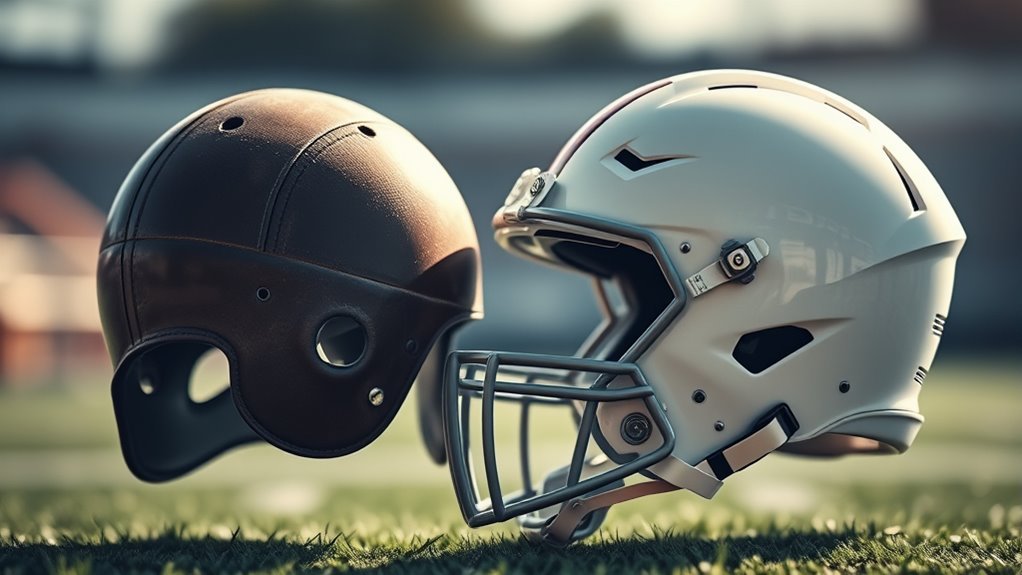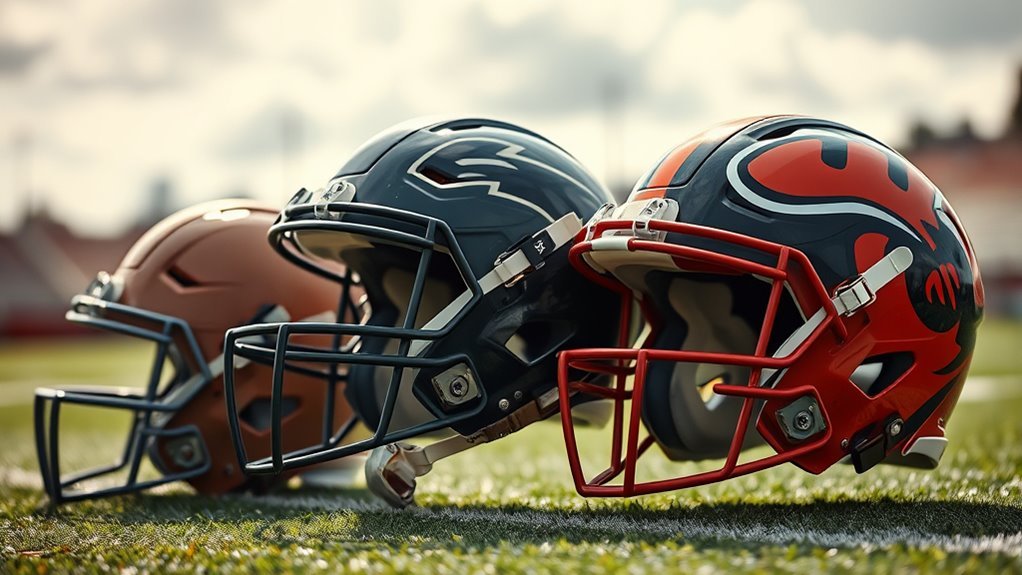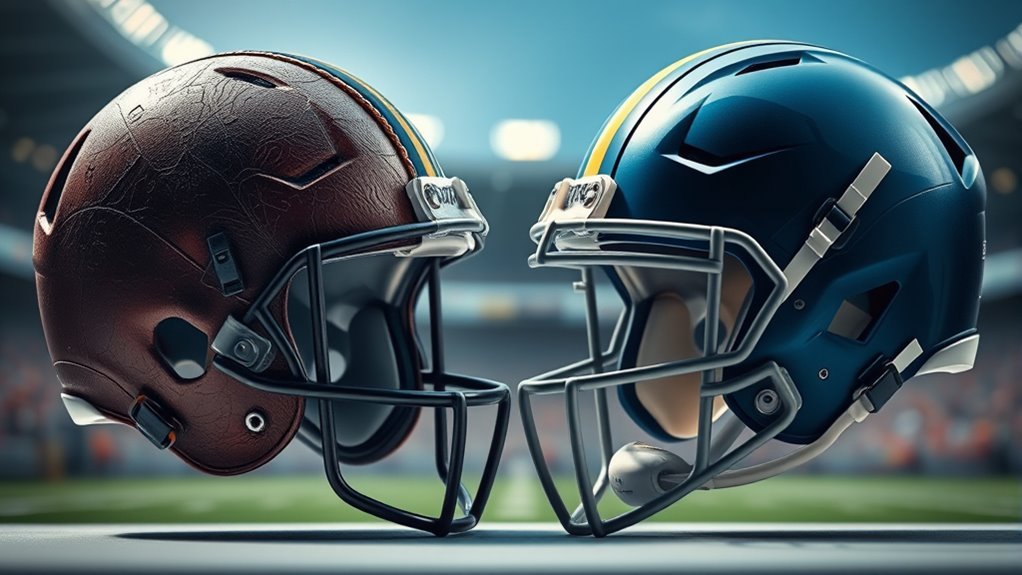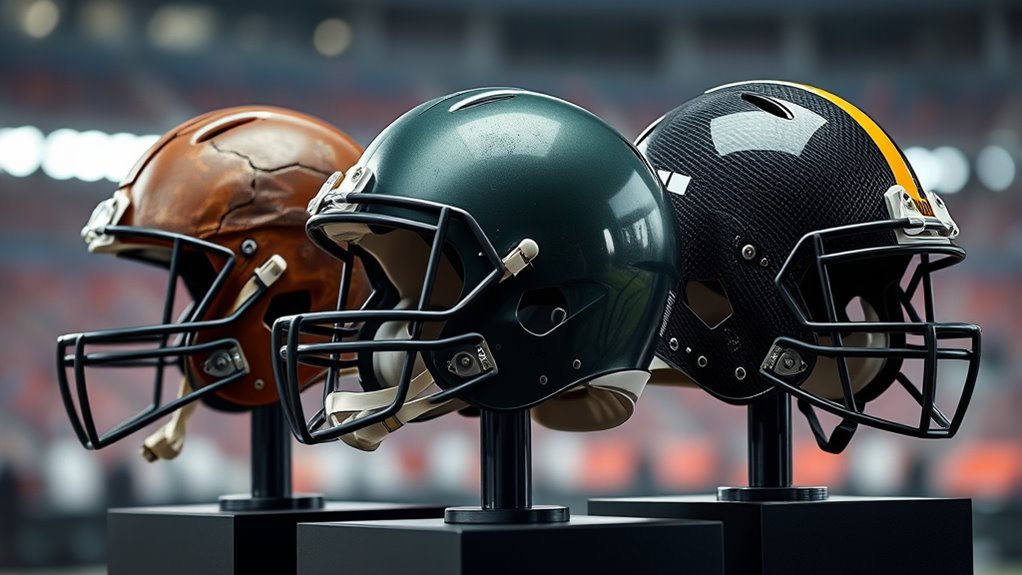Evolution of Football Helmets: Safety and Design
The evolution of football helmets illustrates a significant shift from simple leather caps to sophisticated designs emphasizing safety. Initially, players faced a high risk of concussions due to minimal head protection. Advances in padding and shell materials, like polyurethane foam and polycarbonate, have enhanced safety and comfort. Breakthrough technologies now include energy-absorbing foams and smart materials that monitor impacts. These innovations not only protect players but also improve performance, hinting at more exciting developments ahead.
The Early Days: Leather Caps and Basic Protection

In the early days of football, players relied on simple leather caps for head protection, a stark contrast to the advanced technology of modern helmets. These caps, crafted from basic leather materials, offered minimal cushioning and no structural integrity, leaving early players vulnerable to head injuries. The design was rudimentary, often consisting of a single layer of leather, which did little to absorb impacts. Historical evidence reveals that many players experienced concussions and other head trauma due to the lack of adequate protection. This primitive approach reflects a time when the understanding of safety in sports was limited. As the game evolved, awareness of the need for better protection would eventually lead to significant innovations in helmet design, prioritizing player safety.
The Introduction of Padding and Shells

As the understanding of head injuries grew, the need for improved protection became undeniable. The evolution of football helmets marked a significant shift, introducing advanced padding materials that enhanced safety. These materials, such as polyurethane foam and expanded polystyrene, absorbed impacts more effectively than their predecessors. Alongside these innovations, shell designs evolved to provide a sturdier outer layer. Manufacturers experimented with polycarbonate and fiberglass, resulting in helmets that offered better durability and weight distribution. The integration of padding and shells not only improved impact resistance but also allowed for a more customized fit, giving players greater comfort and mobility. This development reflected a commitment to player safety, paving the way for future advancements in helmet technology.
Breakthroughs in Impact Absorption Technology

While the evolution of padding and shell designs laid the groundwork for safer football helmets, recent breakthroughs in impact absorption technology have truly revolutionized player protection. You’ll find that these advancements greatly enhance impact resistance, ensuring that players can perform with greater confidence. Key innovations include:
- Energy-absorbing foams: These materials dissipate force upon impact, reducing the risk of concussions.
- Smart materials: Incorporating sensors, they monitor impacts and provide real-time data on player safety.
- Multi-layered designs: Different materials work together to absorb various levels of impact, optimizing protection.
- Customized fitting: Advanced technologies allow for personalized helmet shapes, ensuring better contact and absorption.
These material advancements not only improve safety but also empower players to focus on the game.
Modern Designs: Aesthetics Meets Functionality
Although safety remains the primary focus in helmet design, modern aesthetics play an equally essential role in attracting players and fans alike. Today’s helmets incorporate aerodynamic features that enhance performance while offering customizable designs that let players express their individuality.
| Feature | Description |
|---|---|
| Aerodynamic Design | Reduces drag, improving speed |
| Customizable Colors | Allows personal expression |
| Lightweight Materials | Enhances comfort and mobility |
These innovations not only reflect the spirit of the game but also guarantee that players feel confident on the field. As helmets evolve, the integration of style and safety becomes increasingly significant, allowing you to enjoy both protection and personal flair in your gear.
The Future of Helmet Safety and Innovation
The ongoing advancements in helmet design reflect a growing recognition of the importance of both safety and innovation in football. As you look to the future, consider how smart helmets equipped with sensor technology can revolutionize player safety. Here are four key innovations to watch for:
- Impact Detection: Sensors that monitor and analyze collision force in real-time.
- Health Monitoring: Integration of biometric data to assess player conditions during games.
- Data Analytics: Advanced algorithms to predict potential injuries by analyzing gameplay.
- Custom Fit: Adaptive materials that conform to individual head shapes for peak protection.
These developments aim to create a safer playing environment, enabling players to focus on the game while minimizing injury risks. The future of helmet safety is bright, and innovation is key.
Frequently Asked Questions
What Materials Are Currently Used in Modern Football Helmets?
When it comes to modern football helmets, they’re made with cutting-edge materials that pack a punch. You’ll find a mix of polycarbonate shells for impact resistance and advanced padding technology like expanded polypropylene (EPP) foam. These materials work together to absorb shock and protect players from injuries. It’s essential to stay ahead of the game, ensuring that comfort and safety go hand in hand, giving you the freedom to play without worrying about your head.
How Often Should Players Replace Their Helmets?
You should replace your helmet every 3 to 5 years, depending on its condition and usage. The helmet lifespan is influenced by factors like wear and tear, exposure to impacts, and material degradation. Regular inspections can help assess its integrity, but even minor signs of damage may warrant a replacement. Staying proactive about helmet replacement frequency not only guarantees your safety but also enhances your performance on the field, giving you the freedom to play confidently.
Are Custom-Fitted Helmets More Effective Than Standard Sizes?
Custom-fitted helmets provide significant safety benefits compared to standard sizes. When you wear a helmet that’s tailored to your unique head shape, it enhances comfort and stability, reducing the risk of injury during impacts. Studies show that a snug fit minimizes movement, which can lead to better protection against concussions. So, if you’re serious about safety on the field, opting for custom helmets can be a wise and worthwhile choice for your game.
What Role Do Coaches Play in Helmet Safety?
Coaches play an essential role in helmet safety by implementing effective coaching strategies and prioritizing player education. They guarantee players are aware of proper techniques to minimize head injuries and emphasize the importance of wearing well-fitted helmets. By fostering an environment that encourages open dialogue about safety, coaches empower players to take responsibility for their gear. This proactive approach not only enhances safety but also promotes a culture of awareness and responsibility on the field.
How Do Helmet Designs Vary Between Professional and Youth Football?
Helmet designs differ markedly between professional and youth football due to varying safety standards and technologies. In professional football, you’ll find advanced materials and technology aimed at reducing concussions, while youth helmets prioritize lightweight construction to enhance comfort and youth safety. Professionals often use customized fittings and high-tech padding, whereas youth helmets focus on affordability and basic protection, reflecting the different levels of risk and injury prevention strategies appropriate for each age group.






